Weaver species
Choose different species from drop-down list and press 'Go' button. See Full species list.Lesser Masked Weaver Ploceus intermedius
IUCN: Least concern Discovery: 046Categories: white eggs, , acacias, fruit, waterbirds, gum, baobab, Gymnogene, nectar, Nest use, palm, double nests, Ploceus 5: 'Sitagra',
News items about species
Discovery
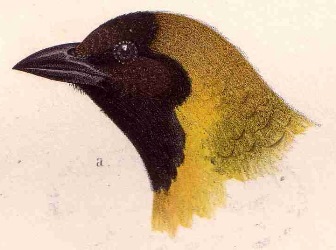
figure from Heuglin 1871 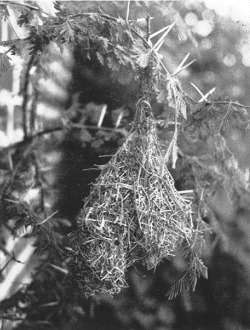
figure from Hoesch 1936 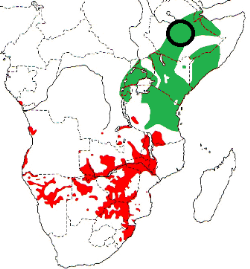
distribution, type locality circled IntroductionThe Lesser Masked Weaver was formally named by Wilhelm Peter Eduard Simon Rüppell, a German naturalist and explorer, especially in north-east Africa. Rüppell was the first naturalist to travel through Ethiopia and many birds are named after him.The Lesser Masked Weaver was collected by Major Sir William Cornwallis Harris, an English military engineer, artist and hunter. Harris led a British diplomatic mission (1841 to 1843) from Bombay to Sahle Selassie, Negus of Shewa, at the time an autonomous district of Ethiopia, with whom they negotiated a commercial treaty. Harris collected birds and other scientific data during the trip. Harris wrote about these travels in 3 volumes (The highlands of Aethiopia) in which he makes occasional reference to birds, but does not appear to have written about the Lesser Masked Weaver which he collected. The type specimen was taken to the East India Company Museum and later [between 1858 and 1971] transferred to the British Museum. Rüppell illustrated many of the birds he described, but did not illustrate the Lesser Masked Weaver. The first illustration of a Lesser Masked Weaver is a colour painting of its head in Heuglin 1871. Interestingly, the species was not illustrated again for many decades and the second illustration pertaining to this species is a photo of a nest in Hoesch 1936. Scientific citationPloceus intermedius Ruppell 1845 Syst. Uebers, pp 71, 76. Shoa, central Abyssinia.Meaning of namesintermedius - Latin: intermedius, intermediate (i.e. sharing characteristics with or acting as a link between two other species).First English nameCabanis' Weaver Bird (Layard 1884). One of the subspecies of the Lesser Masked Weaver was named after Cabanis, hence this early English name - the subspecies is no longer recognised.Alternate namesAbyssinian Masked Weaver, Black-cheeked Weaver, Cababis's Masked Weaver, Cabanis' Weaver Bird, Cabanis's Masked Weaver, Ethiopian Masked Weaver, Masked Weaver.CollectorMajor WC Harris.Date collected1841-43.Locality collectedShoa = Shewa, central Ethiopia.Type specimensOne specimen is known to be in the British Museum (BM 1861.5.8.41). |
The above is based on Weaver Wednesday 2, a weekly series about the discovery of each weaver species.
This species text first appeared as
Weaver Wednesday [163] - Discovery [46]: Lesser Masked Weaver on 2015-07-29
1. Basic biology
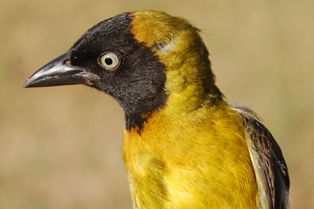

Identification. The Lesser Masked Weaver adult male in breeding plumage (far right) is yellow with a black mask, pale eye and thin bill. Females (right) and non-breeding males are dull coloured, with a pale eye and blue-grey legs. Read about eye colours in weavers, including the Lesser Masked Weaver, here (821 kB). Juveniles have a dark eye. Distribution.
Many subspecies have been recorded but currently there are two accepted subspecies:
There is a slight range expansion of this species in KwaZulu-Natal (see news item). Habitat. The Lesser Masked Weaver occurs in a variety of habitats including acacia savanna, bushveld, open woodland and riverine trees, preferring areas close to water and also human habitation. Food.
The Lesser Masked Weaver feeds on insects, especially caterpillars, termites, and grasshoppers. It also feeds on nectar (mainly of aloes), mulberries, and small seeds. Nestlings are fed on insects.
Breeding. The Lesser Masked Weaver is polygynous and a male can have 2-3 females simultaneously, and probably several more during a breeding season. Nests are usually very close together, and sometimes are suspended below other nests. Colonies may be monospecific or mixed with a variety of other weaver species. Nests have a short, narrow entrance tunnel. Nests look untidy due to short lengths of material sticking out from the nest. Nests are built by the male, and lined by the female, although sometimes no lining is added to breeding nests. Nests are placed in trees, reeds, roof edges of buildings, or from telephone wires. Eggs (usually 2-4) are white or pale bluish white. Incubation is by the female but both parents help feed the young, although the female does more feeding. This is one of the smallest host species to the Diederik Cuckoo. Nest predators include snakes, especially boomslang Dispholidus typus, African Harrier-Hawk Polyboroides typus, and Vervet Monkeys Cercopithecus aethiops. |
The above is based on Weaver Wednesday, a weekly series about weaver species.
This species text first appeared as
Weaver Wednesday [20]: Lesser Masked Weaver on 2012-10-31
2. Breeding facts
| Pair bond Polygynous, with two or three females per male Breeding season Jan-May in DRCongo, Oct-Nov and Mar-May in Rwanda, Mar, May-Jul and Sept in Ethiopia, Jun in Somalia, Mar-Jun in Uganda; in all months except Aug-Nov (peak in Apr) in Kenya; Feb-Apr in Tanzania, Dec and Mar in Angola Sept-Feb in Zambia, Nov-Mar in Malawi, Nov-Feb in Mozambique, Sept-Feb in Zimbabwe, and Oct-Feb in Botswana and South Africa Nest site placed in reeds, or in trees over water or open ground, including exotic species such as eucalypt (Eucalyptus), or even suspended from roof edge or telephone line, 1-3 m above ground Nest building built by male, lined by female Colony size Colonial, up to 60 nests at a site Clutch size 2-3 eggs (average 2.3 in E, C & S Africa) Egg colour plain white or pale bluish-white Egg size average size of 74 eggs 21.4 x 14.7 mm (South Africa) Incubation incubation by female, period 13 days Chicks and nestling period chicks fed by both sexes, male feeding only half as frequently as female, nestling period 15 days |
Breeding information based on Handbook of the Birds of the World, Vol. 15.
3. Photos of Weaver Nests
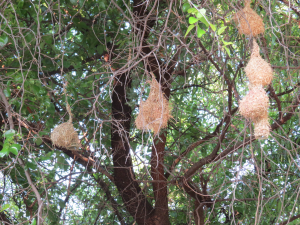 Vm 31115 | 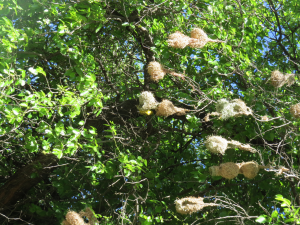 Vm 31067 | 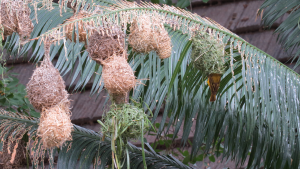 Vm 31039 | 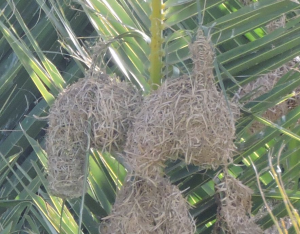 Vm 30683 | 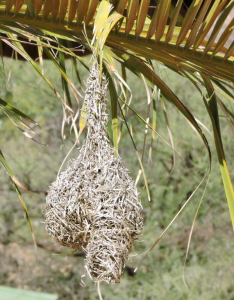 Vm 30379 | 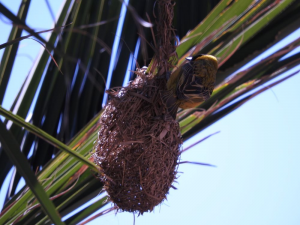 Vm 30287 |
Thumb-nails of most recent PHOWN records - click on one to see its full record
See all PHOWN records for this species here.
PHOWN (Photos of Weaver Nests) provides valuable info on breeding distribution and colony sizes of weavers.
You can contribute by registering and submitting photos at Virtual Museum webpage.
4. Breeding distribution
Google map showing distribution (For species with small ranges you need to zoom in at the correct area to see the range):
yellow blob - range of weaver species; read more about this here.
![]() - PHOWN records with photos
- PHOWN records with photos
![]() - PHOWN records with no photos (Nest Record Cards, other records)
- PHOWN records with no photos (Nest Record Cards, other records)
![]() - Birdpix records
- Birdpix records
![]() - comments on out of range records, or interesting records
- comments on out of range records, or interesting records
![]() - type locality
- type locality
CLICK on the marker on the map to see individual record details.
5. Range changes
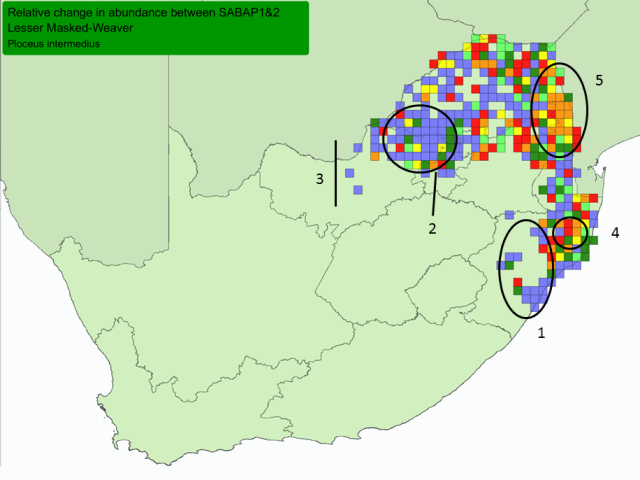
Red, orange and yellow = cells with very large, large, and small relative decreases Blue, dark green and light green = cells with very large, large and small relative increases. Cells = quarter-degree grid cells; Only cells with at least 4 checklists in both SABAP1&2 shown. All cells had this species recorded in SABAP1 or in SABAP2 or in both (more about interpretation at Biodiversity Observations 7.62: 1-13).
Range changes in SA
The points below match the points on the map above. Areas with very large increases include:
Large decreases appear to have occurred:
Range changes elsewhereDR Congo: at Kinshasa, out of range (Punga 2015a). | |||||||||||||||||||||||||||||||||||
The above is based on Weaver Wednesday 3, a weekly series about range changes in South African weaver species.
This species text first appeared as
Weaver Wednesday 3 [244] - Range changes [7]: Lesser Masked Weaver on 2017-02-15








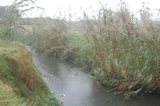


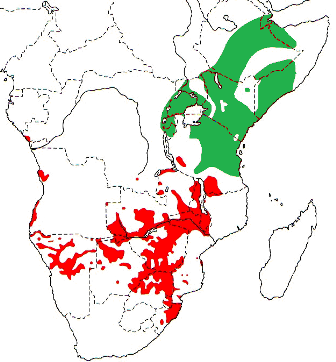 The Lesser Masked Weaver is a widespread weaver in eastern Africa and the northern parts of southern Africa (see map below, based on
The Lesser Masked Weaver is a widespread weaver in eastern Africa and the northern parts of southern Africa (see map below, based on 
